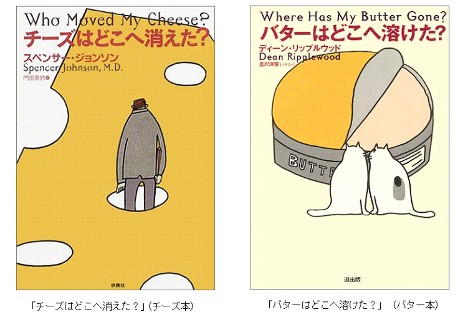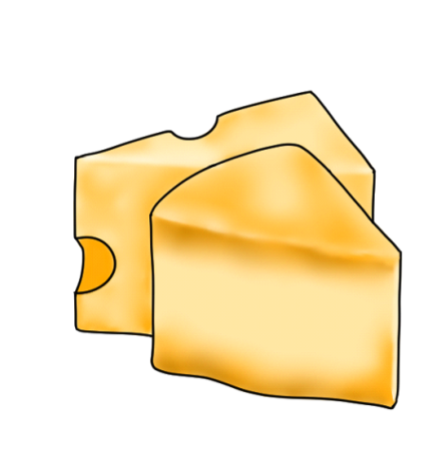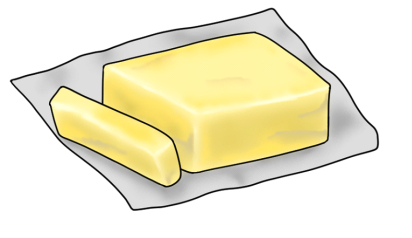The Case of Cheese Book vs. Butter Book
(The Case of “Who Moved My Cheese?”)

[This book looks like that blockbuster book…]
In bookstores, you may find self-improvement books often displayed on the most conspicuous locations.
The book titled “Who Moved My Cheese?” is one of best sellers among such self-improvement books.
Sometime after this book had gained public attention, a book written by another author titled “Where Has My Butter Gone?” was published.
When compared alongside each other as shown above, the titles and covers of both books look similar to each other.
In terms of the contents, they also seem to have common scheme of using allegories to relate massages.
(The English titles of both books have different meanings. Obviously, however, it is the Japanese titles that are subject to the lawsuit and the court decision of the subject case. Therefore, the following descriptions involve only the Japanese versions.)
An Unfair Competition Prevention Act case was brought to court involving the publishers of the two books.
In order to stop the sales of an imitating book, the title and cover design of the book are supposed to fall under the “indication of goods or business” set forth in the Unfair Competition Prevention Act.
Can it be actually subject to the “indication of goods or business”?

[Details of the case]
The lawsuit was filed by FUSOUSHA Co., Ltd. (Hereinafter referred to as FUSOUSHA).
In 1998, FUSOUSHA entered an agreement with an US publisher to publish a Japanese edition of the book titled “Who Moved My Cheese?” (“Where Has My Cheese Disappeared?”) (hereinafter referred to as Cheese book).
The accused was Dou Shuppan Publishing Company (Hereinafter referred to as Dou Shuppan).
In 2001, Dou Shuppan published a book titled “Where Has My Butter Gone?” (“Where Has My Butter Melted?”) (herein after referred to as Butter book).
FUSOUSHA demanded suspension of the sales of Butter book against Dou Shuppan as it fell within the scope of acts under Article 2(1)(i) and (ii) of the Unfair Competition Prevention Act.
[Argument of FUSOUSHA and traverse of Dou Shuppan]
First of all, FUSUOSHA asserted that the title and cover design of Cheese book fell under “an indication of goods or business” set forth in the Article 2(1)(i) or (ii) of the Unfair Competition Prevention Act.
| The original book of Cheese book became the top best-selling business book in the United States in 1999. In Japan, Cheese book won the first place in the general ranking of best-selling books in February 2001 and stayed in the first place for weeks afterwards, with the aggregated number of sales of over 3.3 million copies in 7 months after its publication. By around February 2001 at the latest, the title of Cheese book, i.e., “Where Has My Cheese Disappeared?” as well as the design of the book cover composed of a combination of cheese and a human figure came to be famous as an indication of goods or business of a copyrighted work published by FUSOUSHA. Even assuming arguendo that the book is not famous, it is obvious that the book is well-known among readers i.e., consumers. |
Dou Shuppan denied the facts saying: “we have no knowledge of the facts asserted by FUSOUSHA”.
Next, FUSOUSHA alleged that Butter book was similar to Cheese book.
The basis of this allegation was that the titles of both books were similar to each other and the designs of the books’ covers were similar to each other.
| 1. Cheese book and Butter book are similar to each other in terms of the book titles. (A) “My Cheese” and “My Butter” Both of cheese and butter are the most common everyday dairy products, and they are also similar in terms of the image. (B) The use of term “where” Both of Cheese book and Butter book are written about “where” the object has gone/ disappeared. (C) “Disappeared” and “Melted” The word “Disappeared” in Cheese book signifies that, suddenly one day, something valuable vanished, whereas the word “Melted” in Butter book can be easily associated with the butter having “disappeared”. Besides, the wording of “melt” is not normally used in combination with the word “where”. That way, Butter book makes a point of keeping to the similarity with the title of Cheese book, and even emphasizing the similarity. 2. Cheese book and Butter book are similar to each other in terms of the designs of the book covers. The front cover of Cheese book is composed of the original title of the book in English (dark brown colored), the title in Japanese (red brown colored), whereas the front cover of Butter book indicates a composition almost the same as the composition described above, resulting in a close resemblance to Cheese book. Further, both of Cheese book and Butter book have a color scheme of yellowish or brownish theme colors combined with white and black colors, resulting in overall color tones similar to each other. Furthermore, the size (B6) and number of pages (96 pages) of Butter book are the same as those of Cheese book, as with the indication of the listed price (i.e., “list price: + tax”). 3. Based on the above, the act of Dou Shuppan publishing and selling Butter book that is similar to the indication of goods or business of FUSOUSHA is an unauthorized use of the indication of the present case, which is the famous or well-known indication of goods or business of FUSOUSHA. |
In response, Dou Shuppan traversed.
It argued that neither the titles nor the cover designs of the two books were similar to each other.
| 1. Cheese book and Butter book are not similar to each other in terms of the book titles. The titles of Cheese book and Butter book have only the word “where” in common, however, there is nothing distinctive about the word “where” in itself. Cheese book and Butter book are different in the respect that, in the former, cheese is positively viewed as “something to be sought for in life”, whereas in the latter, butter is negatively viewed as “something you would go on chasing after forever”. Also, the word “Disappeared” gives a negative sense due to the feeling of loss of something lost, whereas, the word “Melted” represents much more natural process, suggesting more neutral quality. In view of the above, the book title of Cheese book is not similar to the book title of Butter book. 2. Cheese book and Butter book are not similar to each other in terms of the designs of the covers. In Butter book, the English title and author’s name are written by using a font different from that of Cheese book, and as for the title and author’s name written in katakana, they also make different impressions on readers due to differences between cheese and batter, as well as between the authors’ names. In addition, the descriptions on the wraparound band of Butter book: “You might be losing something important by chasing after something different to achieve success” clearly shows that Butter book has been written based on a set of values different from that of Cheese book. |
FUSOUSHA further alleged the possibility of some consumers confusing Butter book with Cheese book and ending up buying Butter book
| There are the facts of consumers purchasing Butter book as result of confusing Cheese book with Butter book as described below: 1. Buying Butter book by mistake Consumers who hear or see the title of Cheese book through advertisement and publicity, and are interested in purchasing it do not necessarily remember the exact title of the book. As a result, it could lead to misunderstanding and confusion to cause them to mistakenly purchase Butter book having a similar book title. 2. Mistakenly perceiving Butter book as a sequel It is customary for a best-selling work to be followed by the second round of the series. As such, consumers would mistakenly believe that the “sequel” of Cheese book has been published. In Butter book, the wording of “catching lightning in a bottle twice” is found, which suggests Dou Shuppan’s intention to mislead consumers into believing that Butter book is a sequel of Cheese book. |
Dou Shuppan traversed that no one would have confusion between the two books.
| All of the facts asserted by FUSOUSHA are traversed. Regarding “buying Butter book by mistake”, Dou Shuppan have never received any complaint about mistakenly buying Butter book as asserted by FUSOUSHA. Even assuming arguendo that a purchaser buys Butter book by mistake, it means that Cheese book is not well known, which clearly contradicts with the assertion of FUSOUSHA that the book is well known. Regarding “mistakenly perceiving Butter book as a sequel”, there is no wording of “a second round” nor “a sequel” in Butter book, thus, it is impossible for a reader who wants to buy the sequel of Cheese book mistakenly buys Butter book. |

[Decision of the District Court]
What decision the District Court made?
First of all, a decision was made on whether the title and cover design of Cheese book fell under the “indication of goods or business” set forth in the Article 2(1)(i) or (ii) of the Unfair Competition Prevention Act.
The Court concluded that the title and cover design of Cheese book did not fall under the “indication of goods or business” of FUSOUSHA.
| FUSOUSHA asserts that the title of Cheese book: “To Where Has My Cheese Disappeared?” and the cover design and binding of Cheese book fall under the “indication of goods or business” (the Article 2(1)(i) or (ii) of the Unfair Competition Prevention Act). However, since “To Where Has My Cheese Disappeared?” has been translated by a translator from the original work titled “Who Moved My Cheese?”, and the title is an integral part of the work created by the same person, therefore, there is a doubt about considering that, by publishing Cheese book, FUSOUSHA may exercise the rights such as the right to claim for an injunction by assuming it as its own “indication of goods or business”. |
Next, a decision was made on whether Butter book is similar to Cheese book in the case where the title and cover design of Cheese book fall under the “indication of goods or business”.
The conclusion was that neither the titles of the Cheese book and Butter book nor the designs of the books’ covers were similar to each other.
| Even though examination has been made based on the premise of FUSOUSHA’s argument that it may claim the title and cover design of the book as its own indication of goods or business, the similarity of the indication of goods or business cannot be found for the following reasons: 1. Cheese book and Butter book are not considered as similar to each other in terms of the book titles. The titles of the two books have only the word “Where” and the mark “?” in common. Since “where” is an adverb meaning “to which place”, and “?” is an interrogative, these words convey no independent meaning. Whereupon, the meaningful parts are “My Cheese” and “My Butter”, and “Disappeared” and “Melted”. Regarding the words “Cheese” and “Butter”, the impression and the meaning of each word, and what is associated from each word are significantly different. As for the words “Disappeared” and “Melted”, the wording “disappeared” involves the concept of something existed as an object having been vanished, in contrast, the wording of “melted” involves the concept of something existed as a solid substance having turned into a liquid, thus, the implications of these words are different. 2. Cheese book and Butter book are not considered as similar to each other in terms of the designs of the covers. As for the bookbinding and design, comparing Cheese book with Butter book, it is found that the illustrations on the front covers that continue into the back covers give different impressions to the readers in terms of the numbers and arrangments of cheese and butter, the numbers and arrangements of the characters, the color tones, etc. Therefore, even assuming arguendo that FUSOUSHA may claim the title and the cover design of Cheese book as its own indication of goods or business, the indication of the present case which is the book title and binding of Cheese book is not similar to the book title and binding of Butter book. |
Lastly, the District Court made decision on the possibility of some consumers confusing Butter book with Cheese book and ending up buying Butter book in the case where the title and cover design of Cheese book fall under the “indication of goods or business”.
The Court was of the opinion that there was no confusion between Butter book and Cheese book.
| FUSOUSHA alleges that there are facts that readers misunderstand Butter book as Cheese book and purchase Butter book. However, none of the arguments presented by FUSOUSHA is sufficiently supported as discussed below: 1. “Buying Butter book by mistake” cannot happen. Since the book title of Cheese book is different from and is not similar to the book title of Butter book, it is quite unlikely that those two books are confused as being the same book. If there is someone who intends to purchase Cheese book but purchases Butter book by mistake, it is because he or she does not remember the book title correctly, and it should be clearly recognizable that Cheese book and Butter book are two different books. 2. It is quite unlikely to “mistakenly perceive Butter book as a sequel”. The book title of Cheese book is not considered as similar to the book title Butter book. Besides, there is no description of “next” or “new” on the book title and binding of Butter book to suggest that it is the sequel of Cheese book, and the authors are also different, thus, even though readers might have an impression that Butter book has been published based on and on the coattails of Cheese book, it should be quite unlikely that they would have an impression that Butter book is the sequel of Cheese book. |
In light of the above, the District Court dismissed the motion of FUSOUSHA.
| In view of the above, the motion of FUSOUSHA for provisional disposition of the present case shall be dismissed due to lack of ground. |
[Opinion of Yamaguchi & Associates]
In this case, it became clear that the book title and cover design of a book do not fall under the “indication of goods or business”.
This is a judicial precedent that shows that even if the book title and cover design of a book involve distinctive characteristics, it is not necessarily possible to get an injunction granted against similar goods under the Unfair Competition Prevention Act.
Commentary by Aki Yamaguchi, Patent Attorney
